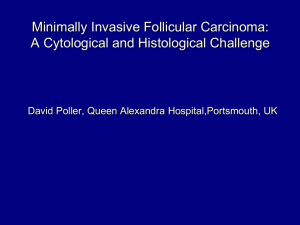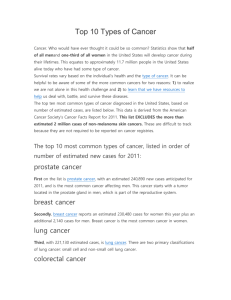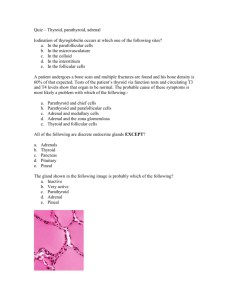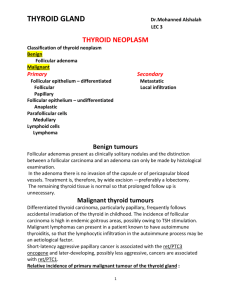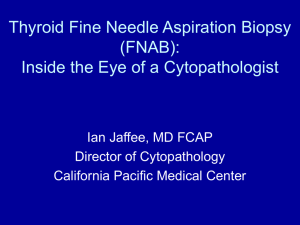BROADSHEET NUMBER 57: PROBLEMS IN FINE NEEDLE BIOPSY OF THE THYROID S
advertisement
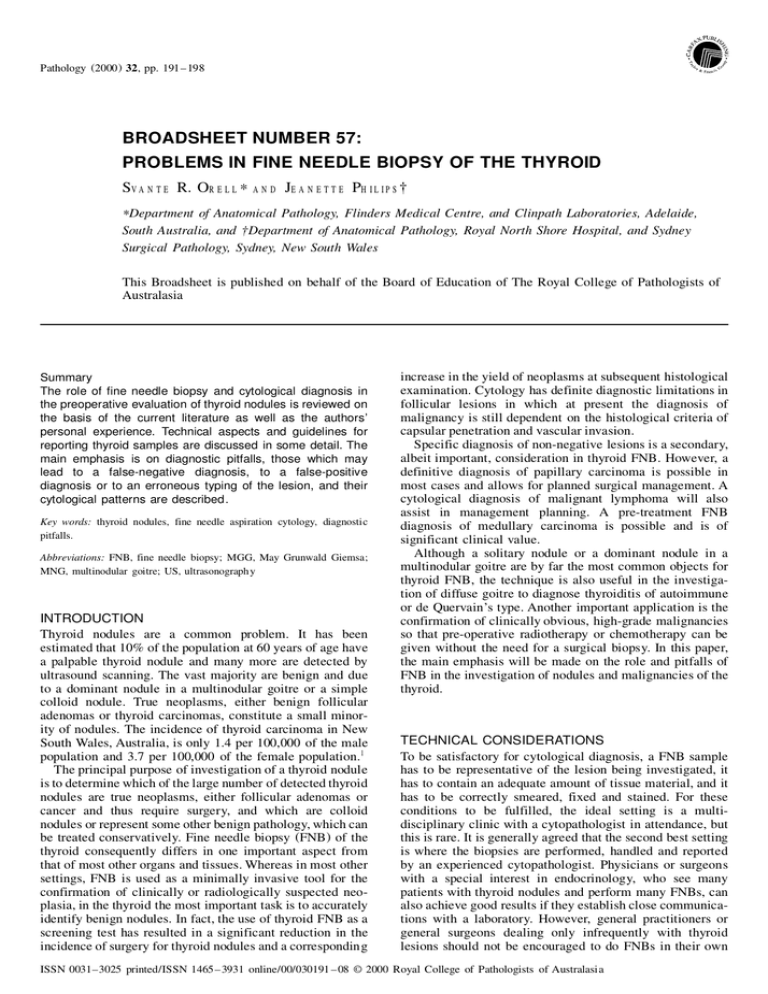
Pathology (2000 ) 32, pp. 191– 198 BROADSHEET NUMBER 57: PROBLEMS IN FINE NEEDLE BIOPSY OF THE THYROID SV A N T E R. OR E L L * AND JE A N E T T E PH I L I P S † *Department of Anatomical Pathology, Flinders Medical Centre, and Clinpath Laboratories, Adelaide, South Australia, and †Department of Anatomical Pathology, Royal North Shore Hospital, and Sydney Surgical Pathology, Sydney, New South Wales This Broadsheet is published on behalf of the Board of Education of The Royal College of Pathologists of Australasia Summary The role of fine needle biopsy and cytological diagnosis in the preoperative evaluation of thyroid nodules is reviewed on the basis of the current literature as well as the authors’ personal experience. Technical aspects and guidelines for reporting thyroid samples are discussed in some detail. The main emphasis is on diagnostic pitfalls, those which may lead to a false-negative diagnosis, to a false-positive diagnosis or to an erroneous typing of the lesion, and their cytological patterns are described. Key words: thyroid nodules, fine needle aspiration cytology, diagnostic pitfalls. Abbreviations: FNB, fine needle biopsy; MGG, May Grunwald Giemsa; MNG, multinodular goitre; US, ultrasonography INTRODUCTION Thyroid nodules are a common problem. It has been estimated that 10% of the population at 60 years of age have a palpable thyroid nodule and many more are detected by ultrasound scanning. The vast majority are benign and due to a dominant nodule in a multinodular goitre or a simple colloid nodule. True neoplasms, either benign follicular adenomas or thyroid carcinomas, constitute a small minority of nodules. The incidence of thyroid carcinoma in New South Wales, Australia, is only 1.4 per 100,000 of the male population and 3.7 per 100,000 of the female population.1 The principal purpose of investigation of a thyroid nodule is to determine which of the large number of detected thyroid nodules are true neoplasms, either follicular adenomas or cancer and thus require surgery, and which are colloid nodules or represent some other benign pathology, which can be treated conservatively. Fine needle biopsy (FNB ) of the thyroid consequently differs in one important aspect from that of most other organs and tissues. Whereas in most other settings, FNB is used as a minimally invasive tool for the confirmation of clinically or radiologically suspected neoplasia, in the thyroid the most important task is to accurately identify benign nodules. In fact, the use of thyroid FNB as a screening test has resulted in a significant reduction in the incidence of surgery for thyroid nodules and a corresponding increase in the yield of neoplasms at subsequent histological examination. Cytology has definite diagnostic limitations in follicular lesions in which at present the diagnosis of malignancy is still dependent on the histological criteria of capsular penetration and vascular invasion. Specific diagnosis of non-negative lesions is a secondary, albeit important, consideration in thyroid FNB. However, a definitive diagnosis of papillary carcinoma is possible in most cases and allows for planned surgical management. A cytological diagnosis of malignant lymphoma will also assist in management planning. A pre-treatment FNB diagnosis of medullary carcinoma is possible and is of significant clinical value. Although a solitary nodule or a dominant nodule in a multinodular goitre are by far the most common objects for thyroid FNB, the technique is also useful in the investigation of diffuse goitre to diagnose thyroiditis of autoimmune or de Quervain’s type. Another important application is the confirmation of clinically obvious, high-grade malignancies so that pre-operative radiotherapy or chemotherapy can be given without the need for a surgical biopsy. In this paper, the main emphasis will be made on the role and pitfalls of FNB in the investigation of nodules and malignancies of the thyroid. TECHNICAL CONSIDERATIONS To be satisfactory for cytological diagnosis, a FNB sample has to be representative of the lesion being investigated, it has to contain an adequate amount of tissue material, and it has to be correctly smeared, fixed and stained. For these conditions to be fulfilled, the ideal setting is a multidisciplinary clinic with a cytopathologist in attendance, but this is rare. It is generally agreed that the second best setting is where the biopsies are performed, handled and reported by an experienced cytopathologist. Physicians or surgeons with a special interest in endocrinology, who see many patients with thyroid nodules and perform many FNBs, can also achieve good results if they establish close communications with a laboratory. However, general practitioners or general surgeons dealing only infrequently with thyroid lesions should not be encouraged to do FNBs in their own ISSN 0031–3025 printed/ISSN 1465– 3931 online/00/030191 – 08 © 2000 Royal College of Pathologists of Australasia 192 ORELL AND PHILIPS rooms. In such conditions, smears received in the laboratory are usually poorly prepared and poorly fixed, and are frequently non-representative and accompanied by little or no clinical information. Results are therefore unlikely to be clinically useful. Samples obtained by any small biopsy technique may not be truly representative. The likelihood that a sample is representative depends on several factors: 1. The skill of the person performing the biopsy, experience in palpating the thyroid, finger tip sensitivity, the ability to project this sensitivity to the tip of the needle while probing the target tissue. 2. Multiple sampling: some workers recommend at least six separate needle passes. We believe this may be too traumatic, at least in an out-patient situation. Three passes are usually sufficient if biopsies are correctly performed. 3. Ultrasonic ( US) guidance can be very useful, particularly when nodules are heterogeneous or difficult to feel.2 The disadvantage is that the procedure takes more time and therefore increases the risk of heavy admixture with blood. It should be used selectively, mainly for repeats when the initial FNB is non-diagnostic and for partly cystic nodules. It is arguable whether very small lesions found incidentally by US examination should be subjected to FNB. FNB samples of thyroid nodules are often voluminous due to admixture with blood and/or fluid. Epithelial cells may be lost or difficult to find in the fluid. The use of thin needles of 27–25 gauge and the non-aspiration technique3 in our experience reduces admixture with blood and fluid and the dilution of cell material. Needling should be rapid and nontraumatic, only a few rapid to and for movements of the needle at each pass. Smears must be prepared quickly before any clotting takes place, since cells tend to become trapped and obscured by blood clot. Cells can often be concentrated if the blood or fluid is spread by tilting the slide and any visible particles are picked up and transferred to another slide for smearing, or using the two-step smearing technique.4 The parallel use of air-dried MGG or Diff Quik smears and wet-fixed Papanicolaou stained ( Pap) smears is strongly recommended. The stains are complementary. Cytoplasmic features, for example of medullary carcinoma and lymphoid cells, are better seen in MGG, and the characteristic nuclear morphology of papillary carcinoma, is better seen in Pap smears. Cell blocks are sometimes useful if samples are bloody. Spare smears should be kept for immunocytochemical staining if malignancy is suspected and a cell suspension for flow cytometry may be diagnostic in case of lymphoma. Clinical complications of thyroid FNB are rare. Of greater interest to pathologists are the “histological” complications reported in recent years: infarction, disruption of the capsule of an adenoma causing difficulties in the evaluation of invasion and highly cellular and vascular reparative processes mimicking neoplasia.5 ANCILLARY TECHNIQUES The ancillary investigations for the phenotyping of cells in FNBs are well known. However, the use of these tests as prognostic indicators and, more importantly, for the differ- Pathology ( 2000 ), 32, August entiation of malignant from benign lesions is as yet still within the bounds of experimentation and research. A few of these techniques will be briefly alluded to: 1. Immunocytochemistry: assessment of LeuM1 as a prognostic indicator in medullary carcinoma has been reported by Schröder et al. 6 Sack and co-workers7 have reported on the possible potential use of HBME-1 in the diagnosis per se of thyroid carcinoma. 2. Ploidy studies: the results of static and flow cytometric DNA ploidy and cell cycle analysis have intimated a worse prognosis with aneuploidy and greater numbers of cells in S-phase in malignant lesions.8 3. Proton magnetic resonance spectroscopy has been investigated for characterisation of thyroid neoplasms and the diagnosis of thyroid follicular lesions on FNB specimens.9 To date the use of this technique has not been recognised as a diagnostic tool in routine FNB of follicular neoplasms. As yet, no ancillary test has been devised to surpass and replace the role of classical FNB and its microscopic interpretation. REPORTING Since the decision whether to remove a thyroid nodule surgically or not depends to a large extent on the result of a FNB, the report must clearly state whether the smears are satisfactory and also the confidence level of any diagnosis. A standardised reporting format is recommended. Guidelines for reporting thyroid FNB smears have been discussed and were reported by the Papanicolaou Society in 1997.1 0 We have used a similar system in our laboratories for several years. Reports fall into one of four categories: unsatisfactory, benign, indeterminate and malignant. The indeterminate category is further subdivided into ‘follicular neoplasm’ ( atypical follicular pattern), which may be benign or malignant, and ‘suspicious’ for other lesions suspicious but not diagnostic of malignancy. Any sample, which contains insufficient cells and other tissue components to allow a proper cytological assessment is inadequate and must be reported as ‘unsatisfactory’ or ‘non-diagnostic’. Around 15% of biopsies fall into this category. Since the main purpose of thyroid FNB is to accurately identify benign nodules, the definition of adequacy takes on a particular importance. To diagnose a nodule as benign a minimum number of well-preserved epithelial cells has to be studied. Many authors require a minimum of five to six cell clusters, each of 10 cells or more, in two slides from separate passes to accept a sample as adequate.1 1 Our criteria are less rigid, but we do require several clusters of well-preserved follicular epithelial cells and the presence of clearly identifiable colloid in more than one sample to call a nodule benign. If this is not the case, the report must clearly say that the biopsy is unsatisfactory and non-diagnostic, and that further investigation or follow up is required.1 2 , 1 3 Repeat FNB will be diagnostic in over 50% of cases. The cytology is benign in about 65% of thyroid nodules. A benign cytology corresponds to either a dominant nodule in MNG or a macrofollicular adenoma. Diagnostic sensitivity reported in the literature varies considerably, 83– 99%, depending on how unsatisfactory and indeterminate reports PROBLEMS IN THYROID FNB 193 Fig. 1 Oxyphilic lesions. (a) Oxyphilic adenoma, (b) oxyphilic carcinoma and (c) oxyphilic cell hyperplasia in Hashimoto’s thyroiditis. Note more prominent nuclear pleomorphism in (a) than in (b). Nuclear hyperchromasia in (b) is artefactual, but the large nucleoli is a suspicious feature. Small dark nuclei in (c) (lower right) represent lymphocytes adherent to epithelial cells. MGG, original magnification, ´ 400. are dealt with in calculations. If these categories are excluded sensitivity is over 90%, the false-negative rate should be below 2% and the predictive value of a negative diagnosis about 95%. Some 15% of nodules are cytologically indeterminate. The majority of these cases are highly cellular nodules of follicular epithelial cells, poor in colloid with or without cytological atypia, lacking obvious criteria of malignancy. The report may express the level of probability that the nodule is benign or malignant, but the cytological prediction is not reliable enough to decide the management of these lesions. On histological examination, at least 75% prove to be benign, mainly microfollicular adenomas, or hyperplastic or adenomatous nodules, but 20–25% are malignant ( welldifferentiated follicular carcinomas). Nodules in this category are therefore usually removed surgically (hemithyroidectomy) to obtain a definitive diagnosis. The clinical parameters, age, sex and the size of the nodule, show a significant correlation with risk of malignancy in nodules cytologically diagnosed as follicular neoplasm and should be taken into consideration when deciding management.1 4 , 1 5 The disadvantage of this cautious strategy is that some patients will require a two-step operation; total thyroidectomy may have to follow if the histological examination shows follicular carcinoma. This is an important limitation of conventional FNB cytology and it is in these cases that there is an urgent need for ancillary techniques capable of providing reliable prognostic information (see the section on ancillary techniques above). To guide the clinician, reports should separate nodules showing the cytology of a follicular neoplasm from truly indeterminate cases, cytologically suspicious but not diagnostic of some other malignancy, usually papillary carcinoma. In suspicious cases, further biopsies, imaging, etc., should be carried out before surgery. We therefore subdivide indeterminate cases into two groups, ‘follicular neoplasm’ (atypical follicular pattern) and ‘suspicious’ (indeterminate ). In terms of reporting, oxyphilic ( Hürthle) cell nodules also fall into the category of follicular neoplasms since in our opinion a confident distinction between benign and malignant oxyphilic neoplasms is not possible ( Fig. 1a,b). Nguyen et al. recently reported some guidelines that may suggest if a Hürthle cell lesion is likely to be benign or malignant.1 6 A malignant cytological diagnosis can be made in about 5% of nodules. Specificity is close to 100% if indeterminate cases are not included, and the predictive value of a positive diagnosis is also close to 100%. If indeterminate cases are included, specificity drops to 50–60%. False-positive diagnoses do occur, mainly in lesions showing some features suggestive of papillary carcinoma and in atypical follicular adenomas. The false–positive rate reported in the literature is 0–7%, and should not exceed 3%. The role of FNB in the management of thyroid nodules is summarised in Fig. 2. Fig. 2 Algorithm summarising the role of FNB in the management of thyroid nodules (AFN, atypical follicular nodule). Reproduced from Monographs in Clinical Cytology, vol. 14,4 with permission from S. Karger, Basel. 194 ORELL AND PHILIPS TA B L E 1 Pitfalls in thyroid cytology Possible causes of false negative diagnosis d Cystic nodules – mainly papillary carcinoma d Follicular variant of papillary carcinoma d Follicular carcinoma with bland cells d Inflammatory anaplastic carcinoma d Lymphoma in Hashimoto’s thyroiditis Possible causes of false-positive diagnosis d Atypical adenoma with bizarre cells d Dyshormonogenetic goitre d Treated Graves’ disease d Post radiotherapy or chemotherapy d Atypical oxyphilic cells in Hashimoto’s thyroiditis d Hyalinising trabecular adenoma d Pseudopapillary structures in non-neoplastic thyroid d Intranuclear vacuoles, nuclear grooves, psammoma bodies in benign lesions Possible errors in tumor-typing d Subtypes of papillary carcinoma d Parathyroid adenoma/follicular neoplasm d Tumors composed of small round cells: Some follicular carcinomas Insular carcinoma Small cell variant of medullary carcinoma Malignant lymphoma Metastatic carcinoma, e.g., breast, urinary tract d Tumors composed of spindle cells: Medullary carcinoma Anaplastic carcinoma Metastatic tumors Soft tissue tumors in the neck d Anaplastic malignancies, primary and secondary PITFALLS IN THYROID CYTOLOGY Systematic presentations of well-known cytological criteria for common thyroid lesions are found in many articles and text books,3 ,1 7 and will not be repeated in this paper. Instead, we will focus on the most commonly encountered pitfalls. These are summarised in Table 1. Cystic nodules Cystic papillary carcinoma is by far the most often encountered pitfall in thyroid cytology and the most common cause of a false-negative diagnosis. That it can easily be underestimated as a benign colloid nodule with cystic degeneration is well documented in the literature. For example, La Rosa et al. 1 8 found the false-negative rate to be 6.4% for cystic nodules compared to 1.4% for solid nodules. FNB samples from the cystic component consist of fluid, which may be thin or thick, colloid-like, clear, turbid, bloodstained, yellow or dark brown. Smears show mainly vacuolated and hemosiderin-containing macrophages, often in large numbers. Well-preserved epithelial cells are few and may be totally absent. Lymph node metastases of papillary carcinoma also tend to undergo cystic change with similar findings in FNB samples. A careful search may reveal occasional syncytial clusters of atypical degenerate cells resembling macrophages but having some of the nuclear features of papillary carcinoma, such as intranuclear vacuoles and longitudinal folds. Prominent cohesive clusters of histiocyte-like cells in cyst fluid from the thyroid or cervical lymph nodes should raise a suspicion of papillary carcinoma. Even a few intact atypical epithelial cells, papillary fragments or psammoma bodies confirm the suspicion. More often, however, several repeat biopsies, if possible with US guidance, may be necessary before a definitive diagnosis can be made. Pathology ( 2000 ), 32, August To avoid this common pitfall, one must consistently observe the minimal requirements for an adequate sample as defined above, to make a benign diagnosis. A diagnosis of a benign cystic nodule should never be made in the absence of a minimum number of well-preserved epithelial cells which can confidently be identified as of follicular type. Colloid is not helpful since it can be abundant both in cystic papillary carcinoma and in the follicular variant of papillary carcinoma. Frequent use of US to guide the needle to any solid components contributes significantly to the correct diagnosis of these lesions. The follicular variant of papillary carcinoma As in intra-operative frozen sections, the presence of follicular structures with colloid may suggest a benign follicular nodule. However, the characteristic nuclear features of papillary carcinoma – a fine dust-like chromatin, intranuclear vacuoles and nuclear grooves – are present and point to the correct diagnosis.1 9 , 2 0 In fact, these features are much easier to appreciate in smears than in tissue frozen sections. The presence of globules or balls of dense abnormal colloid has been described as a feature suggestive of this type of papillary carcinoma.2 1 Follicular carcinoma with bland epithelial cells Many well-differentiated follicular carcinomas are composed of bland epithelial cells, which show no obvious cytological criteria of malignancy ( Fig. 3a). As already pointed out above, the ability of conventional cytology to predict biological potential is limited in this respect. In fact, even smears from distant metastatic deposits of follicular thyroid carcinoma can sometimes appear indistinguishable from benign follicular cells. It is hoped that ancillary techniques will be able to solve this problem in the not too distant future. Anaplastic carcinoma with an inflammatory reaction Some anaplastic carcinomas may be associated with a prominent inflammatory reaction. The malignant cells, although showing every evidence of malignancy if seen clearly, may be few in number and obscured by numerous inflammatory cells mainly neutrophils. It is possible to mistake such tumors for suppurative thyroiditis, particularly since the clinical presentation may also be confusing. Malignant lymphoma in association with Hashimoto’s thyroiditis Autoimmune thyroiditis may have an extremely florid lymphoid component, which may dominate smears. Multiple samples ( at least three) from different areas are important. One sample may show a pattern diagnostic of Hashimoto’s thyroiditis, whereas another sample from the same thyroid may consist entirely of lymphoid tissue suggestive of a florid reactive lymphoid hyperplasia or lymphoma. A florid lymphoid component is a common finding in younger patients with a relatively short history of goitre. When present in an older patient, over 50– 60 years of age, it should raise a suspicion of lymphoma, and routine cytology may need to be supplemented by flow cytometry or other investigations. PROBLEMS IN THYROID FNB 195 material, including dendritic reticulum cells with the characteristic background of syncytial cytoplasm, is often present. The cell population of a low-grade lymphoma is also mixed, but the numerically predominant cell is of centrocytic type, not lymphocytes. In some cases of lowgrade lymphoma of MALT type, non-neoplastic germinal centers may be preserved, and this can make a cytological diagnosis particularly difficult. Large cell lymphoma usually does not cause diagnostic difficulties. A clinical or cytological suspicion of lymphoma can in most cases be confirmed by flow cytometry performed on a FNB sample. In our experience, flow cytometry is more reliable than immunocytochemistry performed on smears ( directly prepared or from a cell suspension). The alternatives are core needle biopsy or open surgical biopsy. Atypical follicular adenoma with bizarre cells Some follicular adenomas can focally show severe nuclear pleomorphism including marked variation in size and shape of nuclei, bizarre multinucleation, hyperchromasia and prominent nucleoli ( Fig. 3b). In other tissues, such pleomorphism would be regarded as cytological evidence of malignancy. However, in the absence of vascular or capsular invasion on subsequent histological examination, a diagnosis of carcinoma cannot be made and the clinical behavior of such lesions is usually benign. Marked anisokaryosis is a common feature of many endocrine organs and cannot in itself be taken as evidence of malignancy. In fact, uniform nuclear enlargement without much variation in size and shape is more suggestive of malignancy in follicular thyroid lesions than pleomorphism. Nuclear hyperchromasia and coarseness, and irregular distribution of chromatin, are stronger indicators of malignancy, but are not often obvious in well-differentiated follicular carcinoma. Mitotic activity and necrosis are only seen in less well-differentiated tumors. Dyshormonogenetic goitre: iatrogenic atypia Severe and cytologically worrying anisokaryosis and nuclear atypia of similar appearance to that of atypical adenoma is also a feature of dyshormonogenetic goitre. It can also be found in patients with Graves’ disease treated with antithyroid drugs and following radiotherapy, for example for malignant lymphoma. This is a further reason to take great caution in interpreting nuclear atypia and pleomorphism in FNB smears of the thyroid. Full knowledge of the patient’s history and other clinical data is imperative to avoid misdiagnosis or a suspicious report, which may lead to unnecessary surgery. Fig. 3 Follicular neoplasms. (a) Follicular carcinoma with a relatively bland cytomorphology. (b) Atypical adenoma showing prominent anisokaryosis and some bizarre cells. MGG, original magnification, ´ 400. The reactive lymphoid population in auto-immune thyroiditis is characteristically mixed, similar to a reactive lymph node. Lymphocytes are numerically predominant and there is a variable, smaller proportion of follicular centre cells, blasts, histiocytes and plasma cells. Germinal centre Oxyphilic cell atypia in Hashimoto’s thyroiditis Oxyphilic cells ( Askanazy cells) in Hashimoto’s thyroiditis sometimes display marked cytological atypia, which may alarm the inexperienced observer. Particularly in cases of long duration, the oxyphilic cells form syncytial clusters and may show considerable nuclear enlargement and pleomorphism. The abundant dense, oxyphilic and finely granular cytoplasm identify these cells as oxyphilic, or Askanazy cells. The lymphoid cells present in the background, some of which characteristically adhere to the epithelial cells, provide the clue to the correct diagnosis. 196 ORELL AND PHILIPS Pathology ( 2000 ), 32, August However, in some cases of long duration, lymphoid cells may be few in numbers and may be overlooked. The pitfalls of cytological diagnosis in thyroiditis were recently reviewed in this journal.2 2 Hyperplasia of oxyphilic cells in Hashimoto’s thyroiditis can form clinically or radiologically noticeable nodules raising a suspicion of neoplasia. FNB smears from hyperplastic nodules may contain numerous oxyphilic cells as in neoplasia, but the characteristic association with lymphoid cells and the finding of the usual pattern of auto-immune thyroiditis in smears from the adjacent thyroid render neoplasia highly unlikely, particularly in the presence of clinical and immunological signs of Hashimoto’s thyroiditis ( Fig. 1c ). Another possible differential difficulty is the uncommon oxyphilic variant of papillary carcinoma, which, like other forms of papillary carcinoma, may be associated with lymphocytic infiltration. Nuclear features typical of papillary carcinoma are usually also present in this variant and should allow a correct diagnosis. However, confident distinction between the different lesions composed of oxyphilic cells is not always possible in FNB smears. Hyalinising trabecular adenoma This uncommon variant of follicular adenoma is difficult to recognise in FNB smears. It can closely mimic both papillary and medullary carcinoma, both cytologically and histologically. Smears are hypercellular and colloid is absent. The epithelial cells are both dispersed and form multilayered syncytial clusters, often with some follicular groupings. Papillary carcinoma may be suggested by the presence of intranuclear vacuoles and longitudinal nuclear grooves in some cells. On the other hand, fragments of dense hyaline stroma may closely resemble amyloid and suggest medullary carcinoma, particularly if the epithelial cells display nuclear hyperchromasia and anisokaryosis. According to Goellner and Carney,2 3 hyalinising trabecular adenoma should be considered if a nodule shows features of both papillary and medullary carcinoma. In our own experience, the few cases we have seen have closely resembled medullary carcinoma. Immunostaining for calcitonin and thyroglobulin helps to establish the correct diagnosis. Features of papillary carcinoma seen in other lesions Certain cytological features regarded as characteristic of papillary carcinoma can occasionally be found in other lesions and even in non-neoplastic thyroid tissue and give rise to false-positive diagnoses. These features can be either microarchitectural or cytological. Papillary structures and cell aggregates simulating papillary carcinoma can be found in Graves’ disease and, more importantly, focally in adenomatoid nodules (Fig. 4a ).2 4 Such pseudopapillary fragments usually lack the distinct even surface formed by palisaded epithelial cells seen in papillary carcinoma and the epithelial cells have the nuclear characteristics of follicular epithelial cells. Trabecular structures or fragments from a trabecular follicular neoplasm may resemble papillary carcinoma even more closely having a well-defined surface contour, but again the nuclear morphology should make distinction from papillary carcinoma possible (Fig. 4b). In our experience, the most Fig. 4 (a) Pseudopapillary structure in multinodular goitre. Papanicolaou, original magnification, ´ 250. (b) Trabecular fragment in follicular carcinoma. MGG, original magnification, ´ 250. (c) Papillary carcinoma. Sheet of epithelial cells with nuclear overlapping and a well defined edge (left). Note large pale nuclei with powdery chromatin, a few with grooves. Papanicolaou, original magnification, ´ 400. frequently seen microarchitectural feature of papillary carcinoma is not true papillary fragments but sheets of cohesive epithelial cells, focally with nuclear crowding and overlapping, and in parts with a distinct “anatomical” border of a row of cuboidal or columnar cells ( Fig. 4c). It is imperative always to correlate microarchitectural with cytological features before making a diagnosis. PROBLEMS IN THYROID FNB 197 Intranuclear cytoplasmic inclusions and longitudinal nuclear folds or grooves, although typically seen in papillary carcinoma, are by no means pathognomoni c thereof. These nuclear features can be found in several other lesions: commonly in medullary and anaplastic carcinoma, occasionally in follicular neoplasms, insular carcinoma, parathyroid adenoma, and even in non-neoplastic thyroid tissue. In most of these lesions, they are only seen in a few of the nuclei, but they can be numerous in anaplastic carcinoma. Psammoma bodies are strongly associated with papillary carcinoma, but have been found in non-neoplastic thyroid tissue and have given rise to a false-positive diagnosis.2 5 , 2 6 These observations highlight the importance of always using a combination of several diagnostic criteria to make a cytological diagnosis. Only exceptionally are single features diagnostic of a given entity. Subtypes of papillary carcinoma Several subtypes of papillary carcinoma have been described: cystic, follicular, oxyphilic, tall cell, columnar cell and diffuse sclerosing. Since the nuclear characteristics – finely granular powdery chromatin, intranuclear vacuoles and longitudinal grooves – are common to all variants, a diagnosis of papillary carcinoma can be made in smears, but it may not be possible to distinguish between the different subtypes. 1 8 The specific problems related to the cystic, follicular and oxyphilic variants have already been discussed. The recognition of the tall cell and columnar cell variants is of some clinical significance due to the more aggressive behavior of these subtypes, which have a tendency to spread beyond the cervical lymph nodes. For example, we have seen a couple of cases of tall cell carcinoma presenting with metastases to lung, pleura and chest wall. Histologically, tall cell papillary carcinoma is defined as having cells that are at least twice as tall as they are wide. This can sometimes but not always be seen also in smears if cells line up in profile. Cells of the columnar variant appear more obviously malignant having a coarser nuclear chromatin. The diffuse sclerosing variant tends to involve the thyroid more diffusely and extensively than the usual form. The presence of numerous psammoma bodies, lymphocytes and squamous metaplasia has been described as suggestive of this form of papillary carcinoma.2 7 Parathyroid adenoma Several papers have dealt with the cytological features of parathyroid adenoma in FNB smears.2 8 Usually, the parathyroid origin of the sample is suggested by clinical and radiological findings. If the cytopathologist is unaware of the possibility that the smear may derive from a parathyroid nodule, the distinction from a thyroid follicular neoplasm is difficult or may be impossible. A high proportion of naked nuclei, poor cell cohesion and a coarser nuclear chromatin would indicate a parathyroid origin. Interestingly, we have seen a parathyroid adenoma of oxyphilic type in which several cells had intranuclear cytoplasmic inclusions. Immunostaining for thyroglobulin may be helpful. Clear colorless fluid aspirated from a thyroid nodule suggests a parathyroid cyst, which should be confirmed by hormone assay. Fig. 5 Tumors composed of small round cells. (a) Poorly differentiated follicular or ‘‘insular’’ carcinoma. (b) Metastatic breast carcinoma in thyroid. Distinction relies on immunostaining for thyroglobulin . Papanicolaou, original magnification, ´ 400. 198 ORELL AND PHILIPS Tumors composed of small round cells A number of thyroid tumors are composed of numerous cells with scanty cytoplasm and relatively uniform, rounded, hyperchromatic nuclei. The cells are both dispersed and form multilayered clusters with nuclear crowding and overlapping, and without a distinct microarchitectural pattern. There may be some microfollicular grouping or rosetting. There is little or no colloid. This pattern is common to some follicular neoplasms, poorly differentiated “insular” carcinoma,2 9 medullary carcinoma of small cell type, malignant lymphoma, and breast carcinoma, transitional cell carcinoma and small cell anaplastic carcinoma metastatic to the thyroid. The close similarity of the smear patterns of insular carcinoma and some metastatic cancers is particularly striking in our experience (Fig. 5a,b). Primary small cell anaplastic carcinoma of the thyroid is very rare. The distinction between these entities can be extremely difficult in routine smears, but is obviously of clinical importance. Immunostaining plays a major role in the differential diagnosis ( thyroglobulin, calcitonin, lymphoma markers, etc.), and clinical correlation is essential. Tumors composed of spindle cells The main entity in this group is the spindle cell variant of medullary carcinoma. Smears may show mainly blandlooking spindle cells and may suggest a benign or possibly low-grade soft tissue tumor of fibroblastic, smooth muscle or nerve sheath origin. Immunostaining for calcitonin solves the problem. If the spindle cells are cytologically obviously malignant, the differential diagnosis is between anaplastic primary thyroid carcinoma of spindle cell type and metastatic sarcoma. The giant cell type of medullary carcinoma may also enter the differential. Anaplastic malignancies The clinically important distinction between primary and metastatic anaplastic malignancy may be impossible in FNB samples, particularly since anaplastic thyroid cancer may not express thyroglobulin. One can only suggest the possibility of a metastatic origin to be pursued by other investigations. CONCLUSION The performance and interpretation of FNB of the thyroid is a challenge to practising pathologists. If the limitations are constantly borne in mind, if sampling and preparation are carried out meticulously, and in the presence of a multidisciplinary approach that includes the doctrine that “FNA should never exclude malignancy if there is a strong clinical suspicion”, it is a proven excellent diagnostic technique. It is therefore considered to be the first “diagnostic/screening” test in the assessment of thyroid nodules. Address for correspondenc e: Dr S.R.O, Clinpath Laboratories, 19 Fullarton Road, Kent Town, SA 5067, Australia. References 1. Delbridge L. Thyroid lumps: which ones need the surgeon’s knife? Mod Med Aust 1994; 37: 38– 43. 2. Danese D, Sciacchitano S, Farsetti A, Andreoli M, Pontecorvi A. Diagnostic accuracy of conventional versus sonography-guided fineneedle aspiration biopsy of thyroid nodules. Thyroid 1998; 8: 15–21. Pathology ( 2000 ), 32, August 3. Zajdela A, Zillhardt P, Voillemot N. Cytological diagnosis by fine needle sampling without aspiration. Cancer 1987; 59: 1201–5. 4. Orell SR, Philips J. The thyroid. Fine-needle biopsy and cytological diagnosis of thyroid lesions. Monographs in Clinical Cytology, Vol. 14. Basel: Karger, 1997. 5. Li Volsi VA, Merino MJ. Worrisome histologic alterations following fine-needle aspiration of the thyroid. Pathol Annu 1994; 29: 99–120. 6. Schröder S, Schwartz W, Rehpenning W, et al. Leu-M 1 immunoreactivity and prognosis in medullary carcinoma of the thyroid gland. J Cancer Res Clin Oncol 1988; 114: 291– 96. 7. Sack M, Astengo-Osuna C, Lin B, et al. HBME-1 immunostaining in thyroid fine-needle aspirations: a useful marker in the diagnosis of carcinoma. Mod Pathol 1997; 10: 668–74. 8. Bäckdahl M, Wallin G, Löwhagen T, et al. Fine-needle biopsy cytology and DNA analysis: their place in the evaluation and treatment of patients with thyroid neoplasms. Surg Clin North Am 1987; 67: 197– 211. 9. Lean C, Delbridge L, Russell P, et al. Diagnosis of follicular thyroid lesions by proton magnetic resonance on fine needle biopsy. J Clin Endocrinol Metab 1995; 80: 1306–11. 10. Guidelines of the Papanicolaou Society of Cytopathology for fine needle aspiration procedure and reporting by the Papanicolaou Society of Cytopathology Task Force on standards of practice. Diagn Cytopathol 1997; 17: 239– 47. 11. Hamburger JI, Husain M. Semiquantitative criteria for fine needle biopsy diagnosis: reduced false-negative diagnoses. Diagn Cytopathol 1988; 4: 14–27. 12. Goellner JR, Gharib H, Grant CS, Johnson DA. Fine needle aspiration cytology of the thyroid, 1980–1986. Acta Cytol 1987; 31: 587– 90. 13. McHenry CR, Walfish PG, Rosen IB. Non-diagnostic fine needle aspiration biopsy: a dilemma in management of nodular thyroid disease. Am J Surg 1993; 59: 415–9. 14. Tuttle RM, Lemar H, Burch HB. Clinical features associated with an increased risk of thyroid malignancy in patients with follicular neoplasia by fine-needle aspiration. Thyroid 1998; 8: 377– 83. 15. Tyler DS, Winchester DJ, Caraway NP, et al. Indeterminate fineneedle aspiration biopsy of the thyroid: identification of subgroups at high risk for invasive carcinoma. Surgery 1994; 116: 1054– 60. 16. Nguyen G-K, Husain M, Akin M-R. Cytodiagnosis of benign and malignant Hurthle cell lesions of the thyroid by fine-needle aspiration biopsy. Diagn Cytopathol 1999; 20: 261–5. 17. Kini SR. Thyroid. In: Kline TS, (ed) Guides to Clinical Aspiration Biopsy, 2nd edn. New York: Igaku-Shoin, 1996. 18. La Rosa GL, Belfiore A, Giuffrida D, et al. Evaluation of the fine needle aspiration biopsy in the preoperative selection of cold thyroid nodules. Cancer 1991; 67: 2137–41. 19. Harach HR, Zusman SB. Cytologic findings in the follicular variant of papillary carcinoma of the thyroid. Acta Cytol 1992; 36: 142– 6. 20. Leung CS, Hartwick RWJ, Bedard YC. Correlation of cytologic and histologic features in variants of papillary carcinoma of the thyroid. Acta Cytol 1995; 37: 645–50. 21. Kumar PV, Talei AR, Malekhusseini SA, et al. Follicular variant of papillary carcinoma of the thyroid. A report of two cases in children. Acta Cytol 1999; 43: 139–42. 22. Kumarasinghe MP, De Silva S. Pitfalls in cytological diagnosis of autoimmune thyroiditis. Pathology 1999; 31: 1–7. 23. Goellner JR, Carney JA. Cytologic features of fine-needle aspirates of hyalinizing trabecular adenoma of the thyroid. Am J Clin Pathol 1989; 91: 115– 9. 24. Faser CR, Marley EF, Oertel YC. Papillary tissue fragments as a diagnostic pitfall in fine-needle aspirations of thyroid nodules. Diagn Cytopathol 1997; 16: 454– 9. 25. Dugan JM, Atkinson BF, Avitabile A, et al. Psammoma bodies in fine needle aspirate of the thyroid in lymphocytic thyroiditis. Acta Cytol 1987; 31: 330–4. 26. Ellison E, Lapuerta P, Martin SE. Psammoma bodies in fine-needle aspirates of the thyroid: predictive value for papillary carcinoma. Cancer 1998; 84: 169–75. 27. Kumarashinge MP. Cytomorphologic features of diffuse sclerosing variant of papillary carcinoma of the thyroid. A report of two cases in children. Acta Cytol 1998; 42: 983– 6. 28. Davey DD, Glant MD, Berger EK. Parathyroid cytopatholog y. Diagn Cytopathol 1986; 2: 76– 80. 29. Pietribiasi F, Sapino A, Papotti M, Bussolati G. Cytologic features of poorly differentiated insular carcinoma of the thyroid as revealed by fine-needle aspiration biopsy. Am J Clin Pathol 1990; 94: 687– 92.
